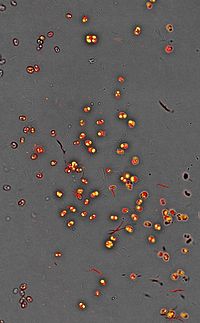
Photo from wikipedia
This study designed a promising integrated model for production of fatty acids and aquaculture inputs using the microalgal biomass of Choricystis minor var. minor. Cultures under photoautotrophic, heterotrophic, and mixotrophic… Click to show full abstract
This study designed a promising integrated model for production of fatty acids and aquaculture inputs using the microalgal biomass of Choricystis minor var. minor. Cultures under photoautotrophic, heterotrophic, and mixotrophic nutritional modes were conducted in fed-batch and the lipids from the different biomasses were extracted and quantified. Then, the biomasses without lipids were used to feed the microcrustacean Daphnia similis. The results indicated the mixotrophic nutritional mode as the most suitable for the production of biomass (8.27 ± 0.70 g L−1) and lipids (32.02 ± 0.11%). In contrast, biomass from the heterotrophic nutritional mode was the most promising for feeding D. similis after lipid extraction (2370 ± 372 Daphnia L−1). The integrated chain developed for biodiesel and aquatic feed is a promising alternative to produce energy with ultra-low environmental impact.
Journal Title: Biomass Conversion and Biorefinery
Year Published: 2020
Link to full text (if available)
Share on Social Media: Sign Up to like & get
recommendations!